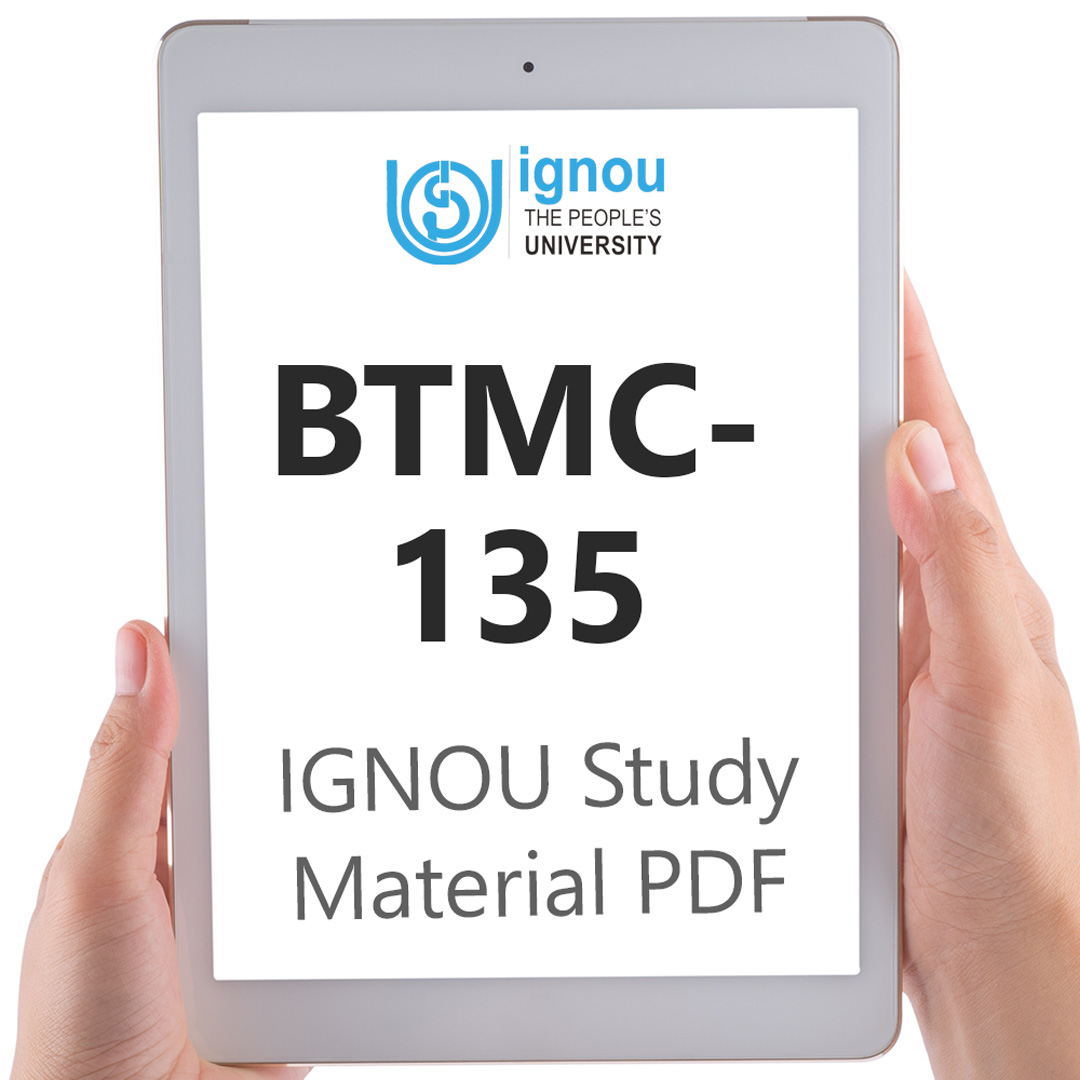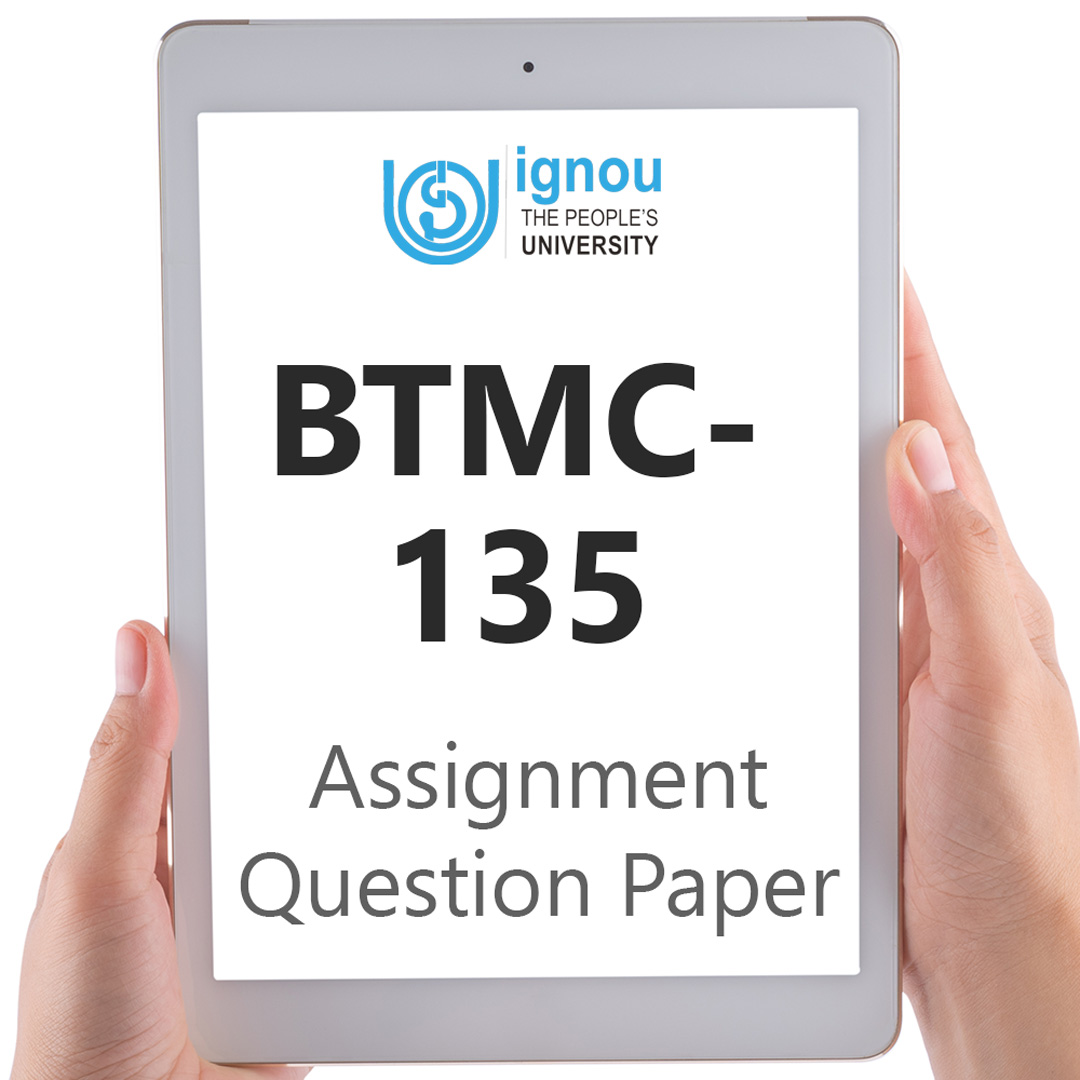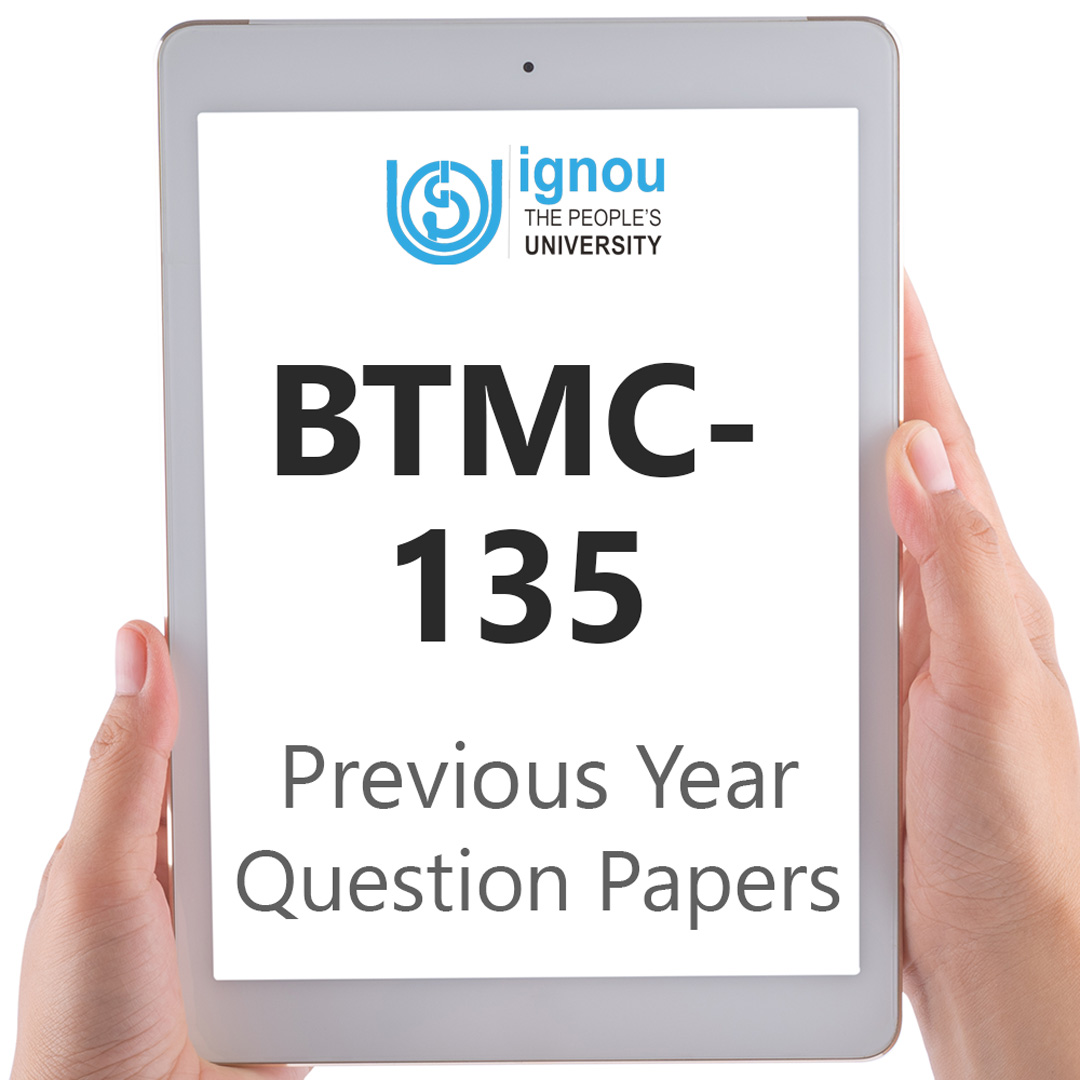If you are looking for BTMC-135 IGNOU Solved Assignment solution for the subject Concept and Impacts of Tourism, you have come to the right place. BTMC-135 solution on this page applies to 2023-24 session students studying in BAVTM, BATS courses of IGNOU.
BTMC-135 Solved Assignment Solution by Gyaniversity
Assignment Code: BTMC–135/TMA/2023-24
Course Code: BTMC–135
Assignment Name: Concept and Impacts of Tourism
Year: 2023-24
Verification Status: Verified by Professor
Section A
Answer the following in about 500 words each.
Q1) Define Motivation. What are the different types of motivation?
Ans) The term "motivation" refers to the psychological processes that are responsible for initiating, guiding, and maintaining behaviours that are purposeful. It involves the internal and environmental forces that motivate individuals to behave in a particular manner, guiding their efforts towards the accomplishment of particular goals. When it comes to defining an individual's level of commitment, amount of effort, and level of tenacity in the pursuit of their goals, motivation is an essential factor.
Various theories and models attempt to understand and categorize motivation, highlighting different types or sources of motivation:
a) Intrinsic Motivation: The internal elements or personal aspirations that are the source of this form of motivation are under question. It is because people find activities to be intrinsically entertaining, fascinating, or rewarding that they choose to participate in those activities. It is not motivated by any pressures or benefits from the outside world. As an illustration, a person might engage in a pastime, such as painting or playing a musical instrument, only for the purpose of experiencing the pleasure and satisfaction that it provides them.
b) Extrinsic Motivation: Unlike intrinsic motivation, extrinsic motivation stems from external factors. It involves engaging in an activity to earn rewards or avoid punishment. These rewards could be tangible, such as money, gifts, or prizes, or intangible, like praise, recognition, or social approval. Extrinsic motivation influences behaviour through incentives and consequences, motivating individuals to act based on the expected outcomes.
c) Primary Motivation: These are innate and fundamental motives essential for survival and well-being. They include basic physiological needs like hunger, thirst, warmth, and the drive for physical safety and security.
d) General Motivation: This category encompasses motives that are not purely physiological but are not entirely learned or social either. These motives include the desire for competence, curiosity, manipulation, activity, and affection. They represent a blend of innate drives and learned behaviours, influencing human behaviour in various settings.
e) Secondary Motivation: These motives are primarily learned or acquired through experiences, cultural influences, and social interactions. They are more complex and diverse, encompassing motives like achievement, affiliation, power, status, and security.
f) Achievement Motivation: This refers to the determination of an individual to achieve success or greatness in their endeavours, frequently by setting objectives that are difficult to obtain and continuing to work toward them until they are accomplished.
g) Affiliation Motivation: This refers to the need for social interaction, belongingness, and maintaining interpersonal relationships. It is characterized by a desire for companionship and social acceptance.
h) Power Motivation: The desire to influence or control others, assert dominance, or have an impact on people and situations.
i) Status Motivation: The pursuit of social standing, recognition, prestige, or respect within a social context or group.
j) Security Motivation: The drive to feel safe, stable, and secure, both physically and emotionally.
It is necessary for a variety of professions, including psychology, education, management, and organisational behaviour, to have a solid understanding of these distinct types of motivation. In the process of explaining human behaviour, leading interventions, and influencing tactics to improve individual performance and pleasure, motivation acts as a core component.
Q2) What are the different components of Tourism System?
Ans) The tourism system is a complex network of interconnected elements that facilitate and support the travel industry. Comprising various components, it works as an integrated system aimed at providing travel experiences and satisfying tourists. The key components include:
Attractions:
Places of interest are the driving force behind tourism. Historical monuments, museums, theme parks, and cultural sites are examples of man-made constructions that can be considered natural wonders. Natural wonders include things like beaches, mountains, and woods. The most important factors that drive people to travel are attractions, which are designed to entice travellers to head to particular locations. Tourists who are looking for a variety of experiences are drawn to these destinations because they offer a wide variety of activities, ranging from culturally rich heritage sites to gorgeous landscapes.
Accessibility:
The ease of access and the availability of various modes of transportation to reach the target location are both aspects of accessibility. There are many different kinds of transportation that are included in it, such as roads, trains, aeroplanes, and waterways. The ability of tourists to access sites is made possible by efficient transit systems and infrastructure, which link various locations and make them accessible. It is essential to have accessibility since it allows travellers to connect with their preferred destinations, which in turn makes the journey possible.
Accommodation:
Accommodation comprises lodging facilities where tourists stay during their visit. This includes hotels, resorts, lodges, guesthouses, and other types of accommodations. These establishments offer temporary residence, ensuring comfort, safety, and amenities to travellers. Accommodation is a critical component as it influences the quality of the visitor's experience and contributes significantly to the tourism economy.
Amenities:
When we talk about amenities, we are referring to the additional services and facilities that are made available to guests while they are there. There are many other characteristics that go under this category, including the availability of entertainment alternatives, recreational activities, infrastructure (including roads and communication networks), vital services (including hospitals and banks), and tourist information centres. Tourists are provided with convenience and delight when they are provided with high-quality amenities, which enhance the whole travel experience.
Activities:
Tourism activities are the experiences and engagements available to tourists at the destination. These activities complement attractions and include guided tours, adventure sports, cultural events, culinary experiences, wildlife safaris, and other forms of entertainment. Activities add depth and richness to the travel experience, allowing visitors to immerse themselves in the local culture and environment.
Local Infrastructure:
Supporting the tourism system is the local infrastructure comprising facilities and services specifically catering to the needs of tourists. These include restaurants, shopping centres, public restrooms, transportation hubs, and other services. Effective infrastructure ensures a seamless and comfortable experience for travellers during their stay.
The synergy among these components creates a cohesive tourism system that attracts visitors, provides them with satisfying experiences, and contributes to the economic development of the destinations. It is the collective functioning and integration of these components that make a destination appealing and enjoyable for tourists, fostering the growth of the tourism industry.
Section B
Answer the following in about 250 words each.
Q3) Define Mill and Morrison’s Consumer Behaviour Model.
Ans) The Mill and Morrison's Consumer Behaviour model is cyclical, depicting a continuous interplay among its core components: the market, travel, destination, and marketing. The model emphasizes that each element influences and reinforces the subsequent ones. Market demand, shaped by internal and external factors, profoundly impacts travel decisions.
Increased demand prompts improvements in transportation networks to cater to this demand, subsequently impacting the nature and scale of tourism infrastructure at destinations. This, in turn, shapes marketing strategies employed by destinations and market segments. The destination's marketing approach significantly influences patron demand, affected by a range of internal and external factors.
A wide range of applications may be found for this model, particularly in the analysis of market demand by taking into account both internal and external forces. It is helpful for travel brokers and tourism promotional agencies, as it assists in the analysis of a variety of purchasing behaviours exhibited by tourists. In addition, it provides direction to agencies who are responsible for destination development and promotion, as well as insights that may be utilised for research and development within the tourism industry.
This model can serve as a framework for tour operators, travel brokers, transportation providers, entertainment organisations, and hospitality enterprises to consider adopting in order to gain a better understanding of the purchasing behaviours of tourists. The fact that they have this insight helps them to put into action successful marketing plans that effectively position their products and services in the market. A market-oriented perspective of the tourist system is portrayed by this model, which places an emphasis on consumer behaviour as the most important component that influences decisions and outcomes in the tourism industry for the tourism industry.
Q4) What is the difference between Travel Intermediaries and DMOs?
Ans) The difference between Travel Intermediaries and DMOs
Q5) Describe the importance of interdisciplinary approach for tourism study.
Ans) The interdisciplinary approach in studying tourism is invaluable due to the complex nature of the industry. Tourism draws upon numerous disciplines, making an interdisciplinary approach crucial for a comprehensive understanding.
In the first place, tourism is a multidisciplinary field that encompasses fields such as economics, sociology, psychology, and environmental studies. An all-encompassing perspective on tourism can be obtained through the integration of several disciplines, which sheds light on the economic impact, societal influences, psychological elements of traveller behaviour, and environmental repercussions of tourism.
Secondly, a strategy that draws from multiple disciplines helps to cultivate a more profound understanding of the myriad facets that comprise tourism. It is possible for researchers and practitioners to comprehend the interconnection of cultural, economic, environmental, and social elements within the framework of tourism if they combine insights from a variety of fields.
In addition to that, this method fosters the development of creative solutions and initiatives. Through the integration of methodologies and points of view from a variety of fields, it enables innovative approaches to problem-solving and the creation of environmentally responsible practises in the field of tourism planning and management.
Additionally, the quality of tourism-related research and education is improved through the utilisation of interdisciplinary collaboration. It fosters the exchange of information, which ultimately results in more in-depth studies, a wider range of perspectives, and a more fulfilling educational experience for students who are interested in pursuing careers related to tourism.
When it comes to unravelling the complexity of tourism, a multidisciplinary approach is very necessary. This approach enables a more nuanced understanding, which in turn influences legislation, destination management, and the development of sustainable tourism.
Section C
Answer the following in about 100 words each.
Q6) What are the different elements of Tourist Destination?
Ans) A tourist destination consists of primary elements crucial for visitor experiences. Attractions, encompassing natural and manmade wonders, form the core, followed by accessibility through transportation modes. Amenities, like local guides and connectivity services, enhance visitor satisfaction. It is essential that the venue provide a variety of activities to ensure that visitors have a varied experience. Genuine experiences that are exclusive to the location are what are meant by the term "authenticity," while a pleasant mood and atmosphere contribute to the appeal of the location. The basic components of a tourist site are summarised by the availability of tour packages that integrate these characteristics into experiences that are marketable.
Q7) What is the difference between Transit Visitor and Excursionist?
Ans)The difference between transit visitor and excursionist:
Q8) How Nature based Tourism can be different from Adventure Tourism.
Ans) Nature based Tourism is different from Adventure Tourism
Q9) What is the role of UNWTO in tourism statistics?
Ans) The UNWTO (United Nations World Tourism Organization) plays a crucial role in collating, analysing, and disseminating global tourism statistics. It establishes standards and guidelines for data collection, providing a framework for member countries to gather and report tourism-related information accurately and consistently. UNWTO conducts surveys, compiles data, and publishes reports, offering valuable insights into global tourism trends, including visitor numbers, expenditure, and tourism's economic impact. By serving as a central hub for comprehensive and reliable tourism statistics, UNWTO supports evidence-based decision-making, policy formulation, and sustainable development within the tourism industry worldwide.
Q10) Define the follow:
Q10a) Tour Guide.
Ans) A tour guide is a knowledgeable individual who leads and informs tourists during visits to historical sites, cities, or natural attractions. They offer insights into local culture, history, and landmarks, providing engaging narratives and detailed information. Guides facilitate smooth travel, ensuring tourists' safety, organizing activities, and offering recommendations. Their role extends beyond information provision, often acting as cultural ambassadors, assisting with language barriers, and creating memorable experiences. Equipped with expertise and communication skills, tour guides play a pivotal role in enhancing tourists' understanding and appreciation of destinations, enriching travel experiences through their expertise and passion for the places they represent.
Q10b) Features of E-Tourism.
Ans) E-Tourism, powered by digital technology, transforms travel experiences through online platforms. Its features include:
a) Accessibility: Enables 24/7 access to travel services and information.
b) Personalization: Tailors travel experiences to individual preferences.
c) Global Reach: Connects travellers worldwide with diverse destinations.
d) Convenience: Facilitates easy bookings, payments, and itinerary planning.
e) Interactivity: Engages users through social media, reviews, and interactive content.
f) Mobility: Provides on-the-go access via mobile apps and optimized websites.
g) Cost-Efficiency: Offers competitive pricing, deals, and comparison tools.
h) Rich Content: Presents multimedia resources, virtual tours, and user-generated content.








